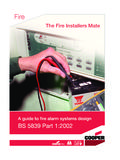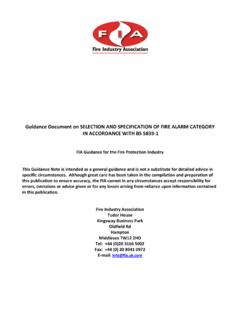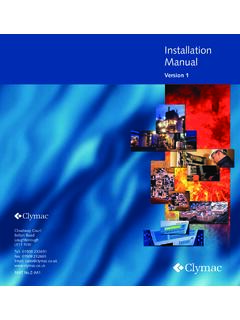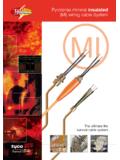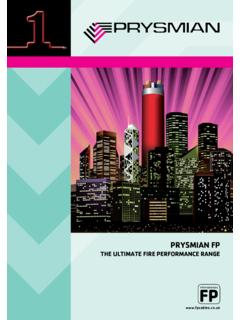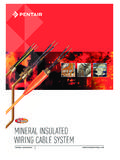Transcription of Fire Alarm Systems Design BS5839
1 AVAILABLE TO. DOWNLOAD ON. THE APOLLO APP. a guide to fire Alarm Systems Design BS5839 . Part1:2013. The Regulatory Reform ( fire Safety) Order (FSO). became law on 1 October 2006. Legally you must comply! What constitutes a fire Risk Assessment and its outcome? What is the FSO? Identifying fire hazards such as fire authorities no longer issue fire sources of ignition, fuel or oxygen certificates and those previously Identifying all people at risk in in force now have no legal status. and around the premises The Regulatory Reform ( fire Safety). Order (FSO) replaced most fire safety Evaluating the risk of a fire starting legislation with one new Order. It and the risk to people from a fire means that any person who has some Removing or reducing fire hazards level of control in premises (normally or risks to people from a fire the employer) must take steps to Protecting people by reduce the risk from fire , consider providing fire precautions how to contain a fire should one Recording the significant findings break out and then also make sure people can safely escape if there is Preparing an emergency plan a fire .
2 Informing and instructing any All fire Alarm designs should be relevant people, including visitors based on an assessment of the risk Providing training for staff All fire Risk Assessments should Reviewing the fire risk be carried out by a competent assessment regularly and make person changes where necessary fire Risk assessments must be Keeping accurate fire risk reviewed regularly assessment records Where does the Order apply? Virtually all premises and nearly every type of building structure and certain open spaces. If you would like to find out more about how Apollo products can help you comply with the FSO please contact us on 023 9249 2412 or visit our website on To download this guide onto your smartphone visit 2. This guide is intended to be an aid to designers and installers of fire detection Systems .
3 It is not to be used as a substitute for BS5839 which should be read in full. In order to help identify the relevant sections, each diagram includes a reference to BS5839 Part 1. fire Alarm and Detection Systems are Section 1 Clause 5. categorised in the following way: Property Protection fire Systems P AFD designed primarily to protect property P1 AFD installed throughout all areas P2 AFD installed only in defined areas Life Protection fire Systems L AFD designed to primarily protect Human Life P1 P2 L1 AFD installed throughout all areas P1 P2. L2 AFD installed in defined areas in addition to L3. L3 AFD installed in escape routes and rooms or areas opening onto these routes L4 AFD installed in escape routes comprising circulation areas and spaces such as corridors and stairways L5 A non-prescriptive system in which protected area(s) and/or the location of detectors is designed to satisfy a specific fire risk objective (other than that of L1 to L4).
4 M system Design to be operated L4 L3 L1 L2 manually (no AFD). L4 L3 L1 L2 *AFD Automatic fire Detection 3. Section 2 Clause 60m MAX. 60m MAX. A person searching a zone for a fire in a non-addressable fire system should not have to travel more than 60m to identify the source of a fire . <25mm X. <25mm X. Section 2 Clause >600mm X. >600mm X. Optical Optical chamber ch chamber ch SMOKE DETECTOR. SMOKE DETECTOR. The sensing element of a smoke detection device (optical smoke or ionisation chamber) should not be less than 25mm below ceiling, and not greater than 600mm below ceiling. 4. X. <25mm Section 2 Clause <25mm X. >150mm X. >150mm X. Thermistor T rm tor Thermistor T rm tor HEAT. HE TDDETECTOR. HEAT. The sensing element of a heatHE TDDETECTOR. detection device should not be less than 25mm below ceiling, and not greater than 150mm below ceiling.
5 100. 90. 80 <4 C X. Section 3 Clause X. 100 Maximum temperature Temperature 70. 90 <29 C. <4 C X. 60. 80. <29 C X. 50 Maximum temperature Temperature 70 Average ambient temperature 40. 60. 30. 50. 20 Average ambient temperature 40. 10. 30. 20. Time of day 10. Time of day The minimum static response to heat devices should not be less than 29 C. above the average ambient temperature, or less than 4 C above the highest temperature the device can expect to experience. 5. SMOKE DETECTORS. Section 2 Clause SMOKE DETECTORS. x = 112m2. x = 112m2. When mounted on a flat ceiling, smoke detection devices have an individual coverage However these radii must overlap to ensure there are of radius. no blind spots'. Therefore individual coverage can be represented by a square measuring giving an actual area coverageHEAT of 112m 2.
6 Per device. DETECTORS. HEAT DETECTORS. Section 2 Clause x = x = When mounted on a flat ceiling, heat detection devices have an individual coverage of radius. However these radii must overlap to ensure there are no blind spots'. Therefore individual coverage can be represented by a square measuring giving an actual area coverage of per device. 6. Treat as a flat ceiling Ceiling with an apex Section 2 Clause Apex <150mm Apex <600mm Apex >150mm Apex >600mm HEAT DETECTOR SMOKE DETECTOR HEAT DETECTOR SMOKE DETECTOR. For ceilings that feature an apex: as long as the height of the apex from the rest of the ceiling is less than 150mm for heat detectors or less than 600mm for smoke detectors, then these can be treated the same as flat ceilings. For higher apexes, a device should be installed at the highest point.
7 The distance to adjacent devices can be increased by 1% per degree of angle of the roof up to a maximum of 25%. Response All categories of system Max Height Detector Type General Area 10% of Area Heat RoR 9m Heat Fixed Smoke/CO point Optical Beam Normal Sensitivity 25m 28m Optical Beam enhanced Sensitivity 40m* 43m*. ASD normal ASD Class C with 5 holes 15m 18m ASD Class C with 15 holes 25m 28m ASD Class B with 15 holes 40m 43m *Supplemented detection recommended unless risk of stratification is minimal. 7. SMOKE DETECTORS. Section 2 Clause 2m 15m 15m In corridors less than 2m wide the horizontal spacing of detectors may be increased, the areas of coverage need not overlap as in the case of a room. Any corridor over 2m wide is deemed a room and device spacing should follow the standard for rooms (see page 6).
8 Please note, heat detectors are not recommended for use in corridors that are escape routes. 8. X. Section 2 clause <1m >1m X. <1m >1m AIR VENT/. AIR CON. AIR VENT/. Do not site detectors less than 1m AIRfrom CONair supply points or air circulating units. X <300mm X >10%. BEAM BEAM. <500mm <500mm Ceiling Section 2 Clause X <300mm X height >10%. <500mm <500mm Ceiling PARTITION. height PARTITION. A device should not be mounted within 500mm of any obstruction. If the top of a solid partition is less than 300mm from ceiling then treat it as a wall. Similarly, ceiling obstructions such as beams should be treated as walls if deeper than 10% of the ceiling height 9. Section 2 Clause LIGHT FITTING/. OBSTRUCTION D. 250mm LIGHT FITTING/. OBSTRUCTION D. (Max).
9 250mm X (Max). <2D. X. <2D. Never mount devices closer than twice the depth of light fittings or other obstructions on the ceiling. Section Clause >800mm >800mm Voids less than 800mm in height need not have independent coverage, unless fire or smoke is able to spread from one area to another through the void or risk assessment shows AFD (Automatic fire Detection) to be necessary. 10. Section 2 Clause LIFT. LIF. IFT SHAFT. SHAFT. F LIFT. LIF. IFT SHAFT. SHAFT. F. LIFT. LIF. IFT SHAFT. SHAFT. F LIFT. LIF. IFT SHAFT. SHAFT. F. Vertical shafts like lifts and open stairways should have a device mounted within of any opening. (This is not necessary for enclosed stairways, because as noted below, there are detectors on every landing within the stairway). Section 2 Clause X.
10 X. Enclosed stairways should have a detector at the top of the stairway and on each main landing. 11. Section 2 Clause 45m MAX. 45m MAX. A person should not have to travel more than 45m to reach a Manual Call Point (25m if disabled person to operate, or rapid fire development is likely). Manual Call Points should be sited at all stair wells and exits from the building. Section 2 Clause (+/ 200mm). (+/ 300mm). The centre of the element of the manual call point should be positioned (+/-300mm) from floor level. (Unless a wheelchair user is likely to be the first person to raise the Alarm ). 12. Section 2 Clause 65dB(A). @ 500Hz to 1,000Hz 65dB(A). @ 500Hz to 1,000Hz +5dB(A). @ 500Hz to 1,000Hz +5dB(A). The minimum sound level should be 65dB(A). @ 500 Hzorto5dB(A).
